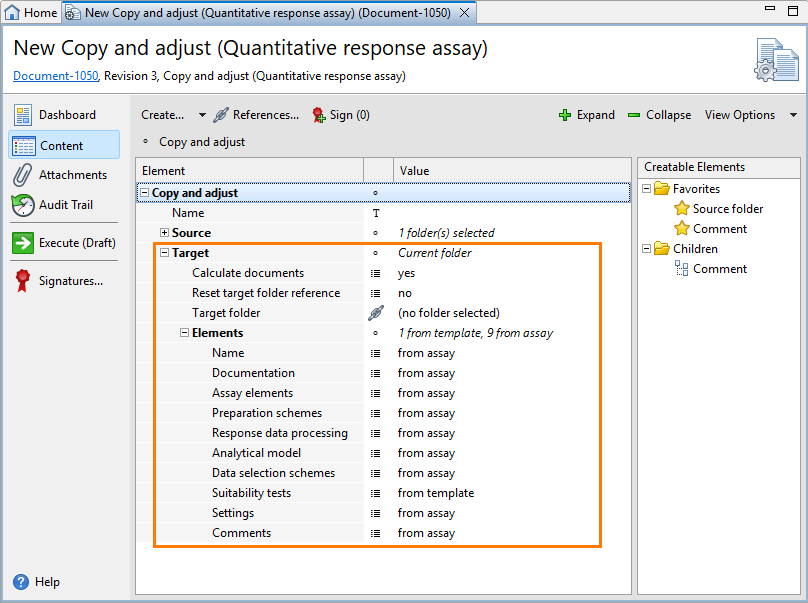Target section
This section allows you to select whether output documents are immediately calculated and in which folder the output documents are created. You can also select whether the respective analytical setting is taken from the source assay or the template.

|
Element |
Description |
Specification |
|---|---|---|
|
Calculate documents |
Select the 'yes' option from the drop-down list to calculate documents immediately after copying the source assays. |
required |
|
Target folder |
Select the folder in which you want to create the new assays. If you do not specify a folder, PLA creates the new assays in the same folder as the Copy and adjust document. |
optional |
|
Reset target folder reference |
Select the 'yes' option from the drop-down list to remove the Target folder element after copying the source assays. |
optional |
Elements
|
Element |
Description |
|---|---|
|
Name |
Specify whether the document name is taken from the source assay or the template. |
|
Documentation |
Specify whether the documentation of the assay is taken from the source assay or the template. Assay documentation lets you provide information on operators, analyte, reagents, and equipment. |
|
Assay elements |
Specify whether you want to use the assay element definitions from the source assay or the template. You can also use the assay element definitions from the template while keeping the assay names. Quantitative response assay documents contain four types of assay elements: The Standard sample, Test samples, Control samples, and Control lines. Control lines may be positive, negative, or blank Control lines that are not diluted. Note: Assay element settings are copied according to their observation group ID.
|
|
Preparation schemes |
Specify whether preparation schemes are taken from the source assay or the template. Preparation schemes define dilution sequences, absolute potencies, and predilution settings of assay elements. |
|
Response data processing |
Specify whether response data processing settings are taken from the source assay or the template. Response data processing allows you to define how your response data is to be processed prior to fitting the regression model. Four types of response data processing are available, that is, adjustment, normalization, transformation, and replicate averaging. |
|
Analytical model |
Specify whether analytical model settings are taken from the source assay or the template. Taking the settings from the template lets you use a different model, such as 4-parameter fit, 3-parameter fit, or 5-parameter fit. You can also change the ANOVA model or the confidence level PLA uses to calculate relative potency confidence intervals. |
|
Data selection schemes |
Specify whether data selection schemes are taken from the source assay or the template. Data selection schemes define range selection settings (including configuration optimizer) and outlier detection methods of assay elements. |
|
Suitability tests |
Specify whether the test system is taken from the source assay or the template. The test system comprises all suitability tests and the setting for handling test exceptions. |
|
Settings |
Specify whether settings for the display of graphics are taken from the source assay or the template. Graphic settings are available for the data plot, the full model, and the restricted model. |
|
Comments |
Specify whether comments are taken from the source assay or the template. |
